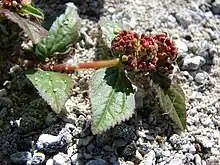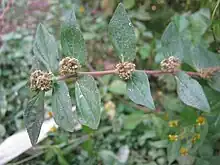Euphorbia hirta
Euphorbia hirta (sometimes called asthma-plant[3]) is a pantropical weed, originating from the tropical regions of the Americas.[4] It is a hairy herb that grows in open grasslands, roadsides and pathways. It is widely used in traditional herbal medicine across many cultures, particularly for asthma, skin ailments, and hypertension.[5] It is also consumed in herbal tea form as folk medicine for fevers in the Philippines (where it is known as tawa-tawa), particularly for dengue fever and malaria.[6][7]
| Euphorbia hirta | |
|---|---|
 | |
| Scientific classification | |
| Kingdom: | Plantae |
| Clade: | Tracheophytes |
| Clade: | Angiosperms |
| Clade: | Eudicots |
| Clade: | Rosids |
| Order: | Malpighiales |
| Family: | Euphorbiaceae |
| Genus: | Euphorbia |
| Species: | E. hirta |
| Binomial name | |
| Euphorbia hirta | |
| Synonyms[2] | |
| |

Botany
This erect or prostrate annual herb can grow up to 60 cm (24 in) long with a solid, hairy stem that produces an abundant white latex.[8] There are stipules present. The leaves are simple, elliptical, hairy (on both upper and lower surfaces but particularly on the veins on the lower leaf surface), with a finely dentate margin. Leaves occur in opposite pairs on the stem. The flowers are unisexual and found in axillary cymes at each leaf node. They lack petals and are generally on a stalk. The fruit is a capsules with three valves and produces tiny, oblong, four-sided red seeds. It has a white or brown taproot.
References
- "Euphorbia hirta". World Checklist of Selected Plant Families (WCSP). Royal Botanic Gardens, Kew. Retrieved 20 July 2019.
- "Euphorbia hirta L.". Plants of the World Online. Royal Botanic Gardens, Kew. Retrieved 2019-07-20.
- BSBI List 2007 (xls). Botanical Society of Britain and Ireland. Archived from the original (xls) on 2015-06-26. Retrieved 2014-10-17.
- "The Royal Botanic Garden Sydney PlantNET Database Entry". Royal Botanical Gardens Sydney. Retrieved 2021-01-23.
- Kumar S, Malhotra R, Kumar D (2010). "Euphorbia hirta: Its chemistry, traditional and medicinal uses, and pharmacological activities". Pharmacognosy Reviews. 4 (7): 58–61. doi:10.4103/0973-7847.65327. PMC 3249903. PMID 22228942.
- Yam, Hilton Y.; Montaño, Marco Nemesio E.; Sia, Isidro C.; Heralde, Francisco M., III; Tayao, Lotgarda (2018). "Ethnomedicinal Uses of tawatawa (Euphorbia hirta Linn.) in Selected Communities in the Philippines: a Non-invasive Ethnographic Survey Using Pictures for Plant Identification". Acta Medica Philippina. 52 (5). doi:10.47895/amp.v52i5.325.
{{cite journal}}: CS1 maint: multiple names: authors list (link) - "'Tawa-tawa': Herbal supplement that can help fight dengue". PhilStar Global. 8 October 2019. Retrieved 7 September 2021.
- "Open Source for Weed Assessment in Lowland Paddy Fields (OSWALD)". Asia IT&C Programme of the European Union. 2007-07-21. Archived from the original on July 9, 2013. Retrieved August 30, 2013.
Further reading
- Pratheepa, Vijayakumari; Sukumaran, NatarajaPillai (13 November 2014). "Effect of Euphorbia hirta plant leaf extract on immunostimulant response of Aeromonas hydrophila infected Cyprinus carpio". PeerJ. 2: e671. doi:10.7717/peerj.671. PMC 4232839. PMID 25405077.
- Quy, Trinh; Ly, Le (April 2014). "An investigation of antidiabetic activities of bioactive compounds in Euphorbia hirta Linn using molecular docking and pharmacophore". Medicinal Chemistry Research. 23 (4): 2033–2045. doi:10.1007/s00044-013-0794-y. S2CID 1918125.